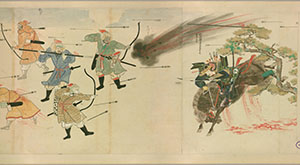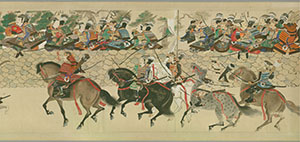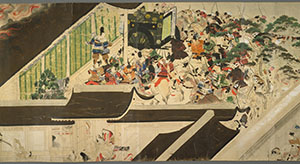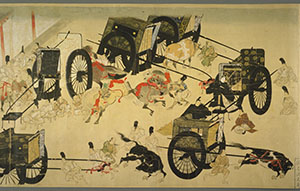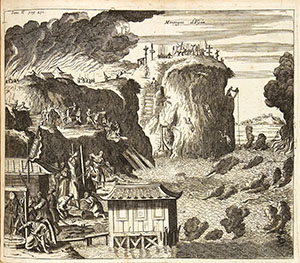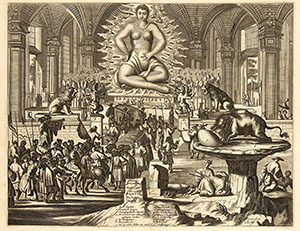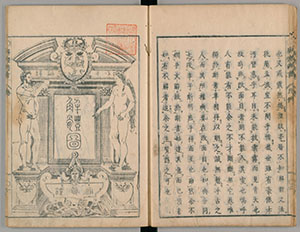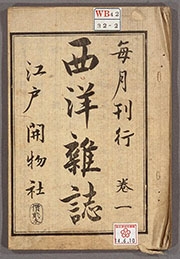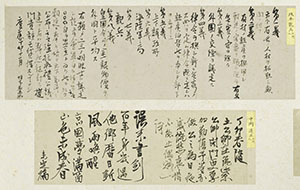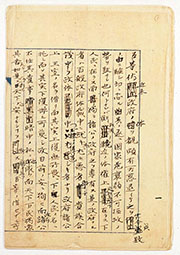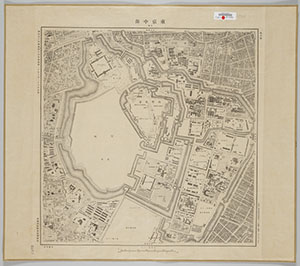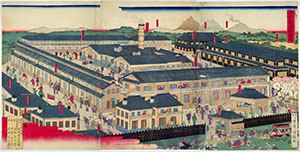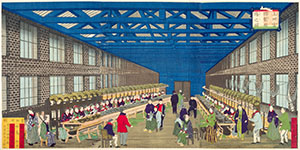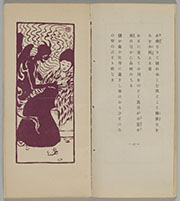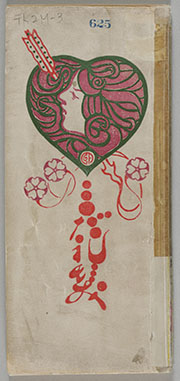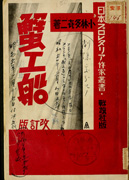70th Anniversary Commemorative Exhibit "A Treasure Box of Books - The 70-year History of the National Diet Library and Its Collections"
- A Treasure Box of Books
- Part 2 Diverse Collections
- Chapter 2 Books you might have seen somewhere
- Section 2 Books you might have seen in your textbooks
Part 2 Chapter 2 Section 2 Books you might have seen in your textbooks
This section is titled "Books you might have seen in your textbooks" and presents materials in chronological order that you would likely have seen in textbooks, TV, or other media.
84 Mukujoko darani, 770 [WA3-1]
Sorin darani, Konpon darani, Jishin'in darani
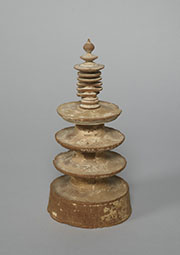 Enlarge Image
Enlarge Image
Digital Collections
The exhibited materials are the so-called Hyakumanto darani (One Million Small Wooden Pagodas and Dharani Prayers), which are the world's oldest verifiable printed matter. The production of the materials was commissioned by the Nara Period Empress Shotoku. One million small wooden pagodas containing block printed paper scrolls with four types of dharani (a type of Buddhist sutra) from the Mukujoko daidarani kyo (Vimalasuddhaprabhasa Mahadharani Suttra) were presented to 10 temples, with the surviving copy being the one which was presented to Horyuji Temple.
85 Moko shurai kassen emaki scroll 2 artwork by TOSA Nagataka and TOSA Nagaaki, 19th century [寄別1-3-1]
Moko shurai kassen emaki scroll 3 artwork by TOSA Nagataka and TOSA Nagaaki, 19th century [寄別1-3-1]
The exhibited materials are leading examples of medieval battle picture scrolls illustrated mainly about Takezaki Suenaga, who was a retainer of Higo Province (present day Kumamoto Prefecture) during the two Mongol invasions during the Kamakura Period. The scrolls were often reproduced during the Edo Period and the exhibited materials are one of these reproductions.
- Scroll 2
- The displayed section depicts Suenaga during the 1274 invasion in a fierce battle with the Mongols, who are using explosives.
Digital Collections
- Scroll 3
- The displayed section depicts Suenaga going to war in 1281.
Digital Collections
86 Heiji Monogatari [emaki] Sanjo-dono yakiuchi no maki (Scroll of Sanjo-dono yakiuchi) by SUMIYOSHI Hiroyuki et al., around 1789-1801 [WA31-4]
Heiji Monogatari [emaki] Shinzei no maki (Scroll of Shinzei) by SUMIYOSHI Hiroyuki et al., around 1789-1801 [WA31-4]
The exhibited materials are picture scrolls depicting the Heiji Rebellion (1159). The originals were created during the Kamakura Period (latter half of the 13th century), and these are faithful reproductions from the Edo Period by the artist Sumiyoshi Hiroyuki.
- Sanjo-dono yakiuchi no maki (Scroll of Sanjo-dono yakiuchi)
- The displayed section depicts the army of Fujiwara no Nobuyori and Minamoto no Yoshitomo launching a surprise attack on the Sanjo Palace of Retired Emperor Go-Shirakawa, and the palace burning.
Digital Collections
- Shinzei no maki (Scroll of Shinzei)
- The displayed section depicts the court nobles being gathered in the imperial palace in order to attempt to capture Shinzei, one of Emperor Go-Shirakawa's closest advisors.
Digital Collections
87 Histoire de l'eglise du Japon t. 2 [par Jean Crasset], Estienne Michallet, 1689 [WA41-29]
Since the introduction of Christianity, missionaries and others have conveyed information from and about Japan to the Western world. The author Jean Crasset was a Jesuit missionary. The displayed section is an illustration related to the Shimabara Uprising, and depicts Christians being persecuted in the "hell" (a location where high temperature gases and boiling water could erupt and spray out) of Mt. Unzen (Nagasaki Prefecture).
88 Atlas japannensis by Arnoldus Montanus English'd and adorn'd by John Ogilby, Printed by T. Johnson, 1670 [WA41-1]
Author Arnoldus Montanus never actually visited Japan himself, but wrote this book based on information conveyed by missionaries and others. As can be seen in the displayed section depicting the Great Buddha, there were a great number of misunderstandings, but the book still proved popular in the West. It is said that Jonathan Swift referenced this book when he wrote the sections of Gulliver's Travels which dealt with Japan.
- Materials related to Japan
-
Since its time as the pre-World War II Imperial Library, the National Diet Library has focused on collecting materials related to Japan (materials about Japan, materials by Japanese authors and artists, etc.) which are published or produced overseas. This is based on the philosophy that, as with the domestically produced materials collected through the legal deposit system, these materials are also an important component of the national collection. These materials are collected through a variety of means including purchase, international exchanges, donations, etc. For collection of new titles, comprehensive collection mainly focuses on academic materials in order to understand the spread of Japanese culture. We also work hard to obtain older books. Some of these old books are designated as rare books and semi-rare books.
89 Kaitai shinsho (New Book of Anatomy) 4 volumes and 1 volume of foreword and illustrations by Johann Adam Kulmus, translated by SUGITA Genpaku, et al., illustrated by ODANO Naotake, SUHARAYA Ichibee in 1774 [わ490.9-15]
Kaitai shinsho (New Book of Anatomy) is a secondhand translation of a German language medical book translated into Dutch. This was the first systematic introduction of Western anatomy. Sugita Genpaku's memoir Rangaku kotohajime (The Beginning of Dutch Learning) details the great difficulty of the translation project which began in 1771.
90 Seiyo zasshi, Kaibutsusha, 1867 [WB42-32-2]
Seiyo zasshi is the first periodical magazine in Japan. This work was published by Western studies scholar Yanagawa Shunsan in an attempt to promote education in social sciences and natural sciences, and includes translations of articles from mainly Dutch academic journals. It began as a monthly publication, and six volumes were published by 1869, with some interruptions between, however it was discontinued the next year after Yanagawa's sudden death.
91 Batabiya Shinbun (Batavian newspaper) edited by Bansho shirabesho (Bureau for the Inspection of Barbarian Books) Rokyukan (1862) [WB43-82]
In the last days of the Tokugawa shogunate newspapers from overseas which were obtained in order to gather information about other countries were translated and published by the government, and this became one of the origins of Japan's modern newspapers. The exhibited materials are an abridged translation of the Javasche Courant public relations newspaper published in Batavia (present day Jakarta) by the Dutch East Indies governor-general's office.
92 Shin seifu koryo hassaku (Eight point program for a new government) (From Boyucho) by SAKAMOTO Ryoma, November 1867 [Ishida Eikichi papers: 1]
This was a proposal for government reform made to the leader of the Tosa domain by Sakamoto Ryoma, based on his Senchu Hassaku (lit. "Eight Point Program Composed Abroad Ship") concept for a new government. It includes some content which served as a foundation for the new Meiji government. The writing on the bottom row is a poem (unfinished) by Nakaoka Shintaro about the period of planning for Osei Fukko (Restoration of Imperial Rule). The scroll Boyucho (Manuscripts by deceased friends) was formerly in the possession of Ishida Eikichi (from the Tosa Domain, he served in the Kiheitai volunteer militia during the last days of the Tokugawa shogunate).
93 Minsen giin setsuritsu kenpaku soko (sanshu) (Draft Petition for the Establishment of a Popularly Elected Assembly (three versions)), January 1874 [Furusawa Shigeru papers: 13]
The Petition for the Establishment of a Popularly Elected Assembly that many are familiar with from history textbooks was a demand by Itagaki Taisuke and others to the government for the establishment of a national assembly. One can get a glimpse into the process of refining the petition from the three rough drafts which remained in the possession of Furusawa Shigeru (a Freedom and People's Rights Movement activist and bureaucrat), who created the draft for the proposal.
94 Gosenbun no ichi tokyo zu Number 5 Tokyo chubu kojo, Sanbo honbu rikugunbu sokuryokyoku, August 1887 [YG915-82]
The exhibited material is one of nine copper plate printed maps published in 1887 by the Land Survey Department of the General Staff Headquarters of the former Japanese army (the predecessor of the present day Geospatial Information Authority of Japan). The survey began in 1876 and was completed in 1884. The original survey map used the French style colored plate method, but the German style single color method was used for publishing.
The Tomioka Seishijo was a government managed model silk mill which was constructed in 1872 as part of the Meiji government's promotion of industry policy. The mill invited experts from France to train female factory employees in order to try and modernize silk production. Ichiyosai Kuniteru was one of the leading painters of Meiji Era nishiki-e (modernization pictures) and was active from the end of the Edo Period through the Meiji Era.
95 Joshu Tomioka Seishijo by ICHIYOSAI Kuniteru, 1872 [本別9-28]
The exhibited material depicts the exterior of the Tomioka Seishijo with the east and west okimayujo (cocoon warehouses), now designated as National Treasures, visible.
96 Joshu Tomioka Seishijo no Zu by ICHIYOSAI Kuniteru, 1872 [寄別7-4-2-5]
97 Midaregami by YOSANO Akiko, Tokyo Shinshisha, 1901 [特52-717]
This is the first poetry collection by poet Yosano Akiko. It is famous for not only featuring Japanese tanka poems, but also beautiful illustrations. These illustrations were produced with Western-style painter Fujishima Takeji.
98 Rashomon by AKUTAGAWA Ryunosuke, Oranda Shobo, 1917 [357-244]
 Enlarge Image
Enlarge Image
Digital Collections
This is the first edition of Akutagawa Ryunosuke's Rashomon, which is covered in most Japanese national language textbooks and is widely known. The exhibited material contains a dedication to the deceased Natsume Soseki. The cover title is by the German language scholar and calligrapher Suga Torao, who was a close friend of Soseki.
99 Kanikosen by KOBAYASHI Takiji, Senkisha, 1929 [F13-Ko12-5ウ]
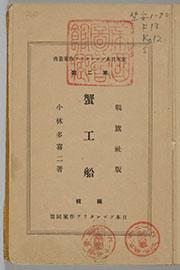 Enlarge Image
Enlarge Image
Digital Collections
This novel is often introduced in social studies textbooks as a masterpiece of proletarian literature. Other than this exhibit material, in the Kanikosen exhibited in the Naimusho Keihokyoku Censorship Collection there are comments by a censor on the cover.
- Naimusho Keihokyoku Censorship Collection
-
Before World War II, publications in Japan underwent censorship by the Naimusho (Home Ministry), and items which were banned from sale or otherwise censored were stored by the Naimusho and the Imperial Library.
After the war, publications held by the Naimusho were confiscated by the United States, however after negotiations between the two governments, several thousand volumes were returned to Japan between 1976 and 1978 and were then stored by the National Diet Library.
When combined with the books held by the Imperial Library, this makes up a collection that currently consists of approximately 2,200 volumes. In addition, even some of the books which have not yet been returned are still viewable in the National Diet Library Digital Collection through joint digitalization with the U.S. Library of Congress.Note: Some of the books have the reasons for the censorship ("disruptive of peace and order" and "corruptive of public morals") and comments from censors written directly in the books.
